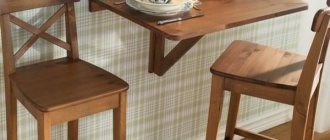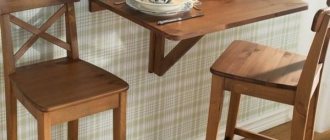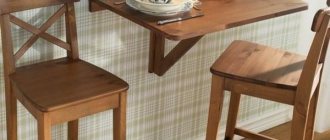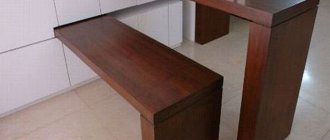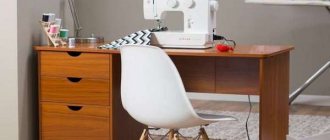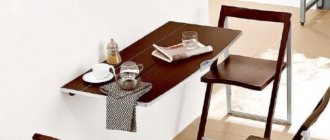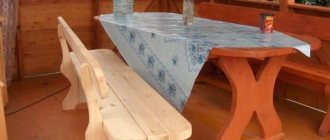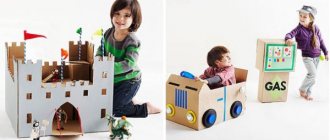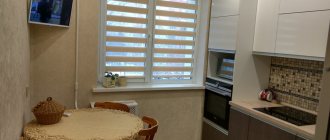Many people's apartments or houses do not have a large amount of usable space that allows them to place all the necessary pieces of furniture in the household. That is why, in such cases, property owners try to purchase products that would combine several useful functions at once, occupying minimal space in the premises.
One of these pieces of furniture is a transformable table-rack, which has recently enjoyed significant popularity among buyers.
Types of folding tables
Even a small table takes up a decent amount of space in the room. In an effort to effectively organize the space of the house, residents of small apartments try to use the free surfaces of the walls. Modern furniture manufacturers offer many types of such tables. Each of them has unique design features, as well as different purposes. Let's look at the main varieties in more detail.
Table transformer
This option is characterized by its most compact size and versatility. It is very easy to use, and raising the tabletop and folding it does not take much time. Owners of Khrushchev-era apartment buildings often buy a folding table for the kitchen. The furniture fits perfectly into the interior of such a room, can have a semicircular or rectangular shape, and takes up a minimum of space.
This variety can be produced either with or without an additional leg for maximum stability. The second option involves exclusively wall mounting. It is recommended not to overload the structure, as it is quite fragile.
Traditional folding table
It features a massive and durable tabletop, which can be mounted on any type of vertical surface. The wall table is considered one of the most durable hanging options and also fits perfectly into any interior. It can easily support large stacks of books and other heavy objects. The mounting location must be fixed to the wall with brackets.
The folding table can be additionally equipped with mirrors, a shelf and other elements that fold together with the tabletop. Most often, the design has a rectangular shape of different lengths and widths. Sometimes there are options with rounded edges. Most models are equipped with one folding leg in the center, which can provide additional stability.
Wall table
The modern furniture market offers a wide variety of folding structures that look like a window sill. A folding table mounted to a wall is equipped with a specialized mechanism that is fixed to the partition. The tabletop is mounted in a raised position, and at the time of use it is lowered. To make it, choose wood or chipboard. This option is considered the simplest and most inexpensive, but is inferior to traditional models in terms of reliability. A hanging table is most often used in situations where space in the room is very limited.
Folding bar counter
This option has a long and narrow tabletop. The bar table is characterized by large capacity. Up to 5 people can sit behind it. Ideal for a kitchen decorated in a modern style. Often used in studio apartments, as it allows you to divide the space into several functional areas. Some models have a foot for installation on the floor, but there are also simple options with the simplest mobile design. Mirrors, glass and other decorative elements can be used as decoration.
Folding table
This retro variety is somewhat reminiscent of transformable side tables, but has one fundamental difference: the dimensions of the tabletop can be adjusted. It is impossible to completely bring the product into a vertical position. When folded, the design takes up less space and turns into a convenient cabinet. This option is often used on balconies and in very small kitchens. The main advantage is compactness and versatility, but the design is quite fragile, which is why it is not recommended to force it with heavy objects.
Mobile folding table
Quite an interesting option, which when folded has the most compact dimensions and can be used as a shelf or cabinet, and if you expand the tabletop, you get a full-fledged work or kitchen table. The main difference between these models is their installation on vertical guides, which make the product as mobile as possible. It becomes possible to move the table along one wall. Most often, such structures are equipped with folding legs, which serve as additional support.
Kinds
Semicircular wall table
A folding table can be made in many ways. There are simply structures mounted on the wall that resemble a shelf. There are also more complex models with runners that allow you to move the tabletop along the wall. The most common types also have design features.
Table transformer
This type includes products that, when folded, become part of other furniture. For example, a cabinet hanging on the wall can easily be turned into a table by folding its door forward and down. A classic example of a transformer is a secretary. The body of a foot-operated sewing machine is often equipped with similar tables. When folded, the transforming table looks like a small cabinet, and when the lid is folded back, the seamstress gets an additional work surface. A built-in table with a retractable tabletop is also classified as this type.
Traditional folding table
In the traditional version, the folding tabletop is attached to the wall using a narrow strip. When folded, the support legs are hidden behind a wooden plane lowered along the wall. When unfolding the table, the lid is raised to a horizontal position. The supports can be attached to the underside of the tabletop or additional parts on the wall. The folded product looks like a narrow console or shelf with a screen. You can put small decorative items on it.
Wall table
If the brackets for a folding table are attached to the wall, and the tabletop is not supported by legs, then the product is called wall-mounted. A do-it-yourself hanging table is made with a fixed tabletop of small width. A retractable part can be located under it, increasing the area.
Folding table
This variety is not necessarily wall-mounted. Most often, a folding model has a narrow base on which 2 folding tabletops are attached with hinges, their width equal to the height of the main part. There are legs inside, which can be rotated to provide support for the folding part. When unfolded, the table reaches the size of a large dining table. It is convenient in that you can unfold only half of the tabletop or use a narrow base of the structure as it.
Step-by-step master class on self-production
Wanting to save money, many people make a table with their own hands. This is not difficult, but requires compliance with certain requirements.
Wall mounted kitchen wall mounted
To make a folding table with your own hands, you will need to prepare plywood sheets; you can also use chipboard or MDF as a basis. Additionally, you will need screws, hinges, confirmations and anchors.
Manufacturing algorithm:
- Prepare a drawing of the model and parts separately. Moreover, it is necessary to draw a diagram according to the exact dimensions of the future product.
- To make a tabletop, use an electric jigsaw to cut the selected material, giving it the desired shape.
- Using a sanding machine, sand the edges of the product and cover them with special tape.
- Prepare supports. This can be a triangle or a support element in the shape of the letter P. For a small wall-mounted tabletop, a triangular-shaped support is most suitable. It is secured with a bracket on the wall and hinges to the tabletop. Using two strips on both sides, the structure can be strengthened.
- Attach the triangular support to the back.
- Mount the structure to the tabletop using hinges.
- Attach the wall table itself.
A suitable place to install a wall-mounted folding table is the wall next to the window sill.
Cut the material into the desired shape, process the edges of the product and cover it with special tape.
Prepare the supports Paint the parts, attach the triangular support to the back, mount the structure to the tabletop Attach the wall-mounted table
Desk folding with cabinet
You need to prepare:
- sheet material for assembling the cabinet box, the thickness of which is at least 16 mm;
- a block for fixing the structure to the wall;
- chipboard or MDF sheets for countertops;
- strip for mounting the product on the wall;
- wooden beams for making supports.
In addition, you will need screws, furniture corners, and a bracket. The manufacturing process itself differs little from assembling a regular wall table, because the cabinet is a box without a back wall:
- The parts are fastened with self-tapping screws and reinforced with metal furniture corners. If desired, shelves and partitions can be secured inside the cabinet using corners.
- The tabletop is cut to the size of the previously made box. The edges are processed and secured to the bottom crossbar of the cabinet using brackets.
- Assemble a U-shaped support from the beams and fix it with loops to the tabletop.
- They make fasteners that will hold the tabletop in the assembled state. The table is ready.
Installing such a model does not require a lot of time and effort; the main thing is to choose the right place so that nothing interferes with the product’s unfolding and folding.
Fasten the parts with self-tapping screws and reinforce with metal furniture corners Cut the tabletop to the size of the box, process the edges and fasten it to the cabinet crossbar Assemble the support and attach it to the tabletop
Make fasteners and install the structure on the wall
If desired, attach shelves inside the cabinet
Mechanism for folding tabletop
The finished structure can be attached to the wall using metal spacers
You can build a folding tabletop yourself using furniture fittings. Thanks to it, you can clearly and correctly think through every detail of the future table.
Brackets for attaching a folding table
The material used is chipboard (new or from old furniture). Finally, to give the finished product an attractive look, apply a varnish coating or cover it with self-adhesive paper. Decor at your discretion.
To secure the tabletop, you will need dowels or hinges used in furniture production.
Required Tools
If you need to make a folding table for a balcony, which will also look like a professional design, then you simply won’t be able to do it without modern tools.
By the way, in addition to hand tools, you also need electric ones. Here is a list of tools without which a wall-mounted folding table will not work:
A jigsaw is a must. It will help you cut table material accurately and efficiently. You can replace it with a hacksaw. But using it, you can forget about the perfect cut; for it, the cut will have to be polished.
A milling machine and attachments for it will be needed for processing edges, drilling holes and cutting grooves. Plus, it can be used to cut out decor for furniture.
A sander will be needed to smooth the surfaces.
You definitely can’t do without an electric drill. It will be used to drill holes. Plus, it requires drills for concrete and wood.
Clamps may be needed if glue and screed are used as temporary fasteners. They should not be used as permanent fixtures.
You will also need an office for marking (markers, tape measures), if you have a level and a square, this will be a plus.
You can replace them with manual analogues, but it will take more time. It’s too early to give recommendations on the quantity and type of material, because everything is individual.
Tools needed to assemble a desk-rack?
For example, you bought a corner table-shelf. But as you know, all furniture comes from an online store in disassembled form. And the buyer will need to begin assembling it at home.
What tools are needed for this? If you bought imported furniture, then the set of tools necessary to assemble it will be included.
Our domestic manufacturers also try to imitate their imported colleagues, but they do not always succeed. Therefore, it is best to stock up on a set of plumbing tools.
- Folding chair: main categories, features of creation and use in the interior (90 photos)
- Computer chair - modern models, features of choice and the best ideas for use (85 photos)
Extendable table - features of application and methods of arrangement in the interior (80 photos)
Models
Furniture manufacturers offer a wide range of tables, which differ in tabletop shapes, design types, sizes, fastening features, the presence or absence of certain components (for example, legs), and materials. In addition, the models differ in design: color and texture of the countertop surface. There are expensive options made from natural materials (solid wood or glass) and more budget ones that imitate natural stone or valuable wood species (most often plastic or veneered surfaces). Some tables are complemented by decorative inserts from other materials, carvings, inlays, and furniture fittings.
Forms
Folding tables are available with four tabletop shapes:
- Square. Ideal for a small family of three.
- Rectangular. The tabletop of the model is more spacious and can be used even for modest feasts with guests. Such folding tables are fixed both across the wall and along it.
- Semicircular. Tabletops of this shape have a small capacity and are therefore rarely used. Although the option looks original and suits classic interiors and Art Nouveau furnishings.
- Round and oval. The rarest variations. It looks stylish and unusual, but is rarely used due to its small capacity. The option is optimal as a dressing table in the bedroom or a workspace for one person.
In rooms with complex configurations, tables of non-standard shapes can be used. They are usually made to order.
Construction type
By type of design, folding tables are classified into the following types:
- Transformers. They can be wall-mounted or wall-mounted. The main distinguishing feature of the design is its versatility. If desired, it can turn into a compact workplace, replacing a desk, or into a full-fledged dining area.
- Folding table. A simplified version of the transformer, which does not have additional features. When folded, the tabletop assumes a vertical position, but at the same time a static “piece” remains against the wall, so the model is not completely assembled. Can be wall-mounted or wall-mounted. A striking example of the second option is a book-table. It became the first prototype of a folding table, which was familiar to every person from Soviet childhood. It was a tall “coffin” with two tabletops on either side of a narrow board in the middle. The “wings” are usually in a lowered state. When you need to set the table for a holiday, they are raised and fixed in a horizontal position. This piece of furniture really saved large feasts, since its area when unfolded increased several times. At a time when the model did not fold out, its narrow static tabletop was used as a shelf. When assembled, the “book” takes up very little space, but is still inferior to folding tables built into the wall.
- Folding. The simplest and most popular model. The table can be mounted on any vertical surface, be it a wall or the front of a cabinet. In addition to the tabletop, such models are usually equipped with a number of shelves. If the table is located in the kitchen, then they are filled with dishes. When the model is used for work, books and writing materials are stored in the shelves. The design is designed for heavy loads. As a rule, it has no legs, so the fastening to the wall must be reliable so that the table does not collapse at the feet of the owners. The tabletop does not rise, but folds down. This is its main difference from the folding model.
- Mobile folding table. The model is in many ways similar to the previous one, but differs in mobility. The tabletop moves along a guide mounted into the wall. This folding table is convenient for small apartments with a non-standard layout.
- Hanging. Tables without legs. They are compact, as they are not designed for heavy loads.
- Folding bar counter. It features a narrow, elongated tabletop. Ideal for small kitchens. Fixed high, like a classic bar counter. Often complemented by the same high chairs.
Although transformers and folding tables belong to the folding category, in classic models the tabletops are lowered during folding, and not raised, as happens in the two cases described above.
Model Variations
Shelving tables differ from each other not only in the material they are made of, but also in appearance and technical characteristics. This in turn affects the functionality of the products. There are desk, computer, dining and wall-mounted shelving tables on the market, which are popular among buyers.
Writing
Transformable desk-racks are the simplest in design. Some models of such products have additional properties that allow writing or reading more correctly - in accordance with the rules and regulations determined by experts.
Computer
Transforming computer tables in most cases differ in their appearance and configuration of elements. It allows you to easily place on the product a computer, laptop, keyboard, mouse, speakers and some other devices that the buyer may need.
Dining
A distinctive feature of this transforming table model is its ability to be used for joint breakfasts, lunches and dinners. As a rule, such products are made of materials that can be easily washed or cleaned of dirt.
Transformable dining tables can have different overall dimensions - for one, two or four people.
Some models allow you to easily accommodate even a whole family.
Wall option
A table in the bedroom may be needed quite rarely. In turn, a shelf that can be placed on the wall can become not only a functional element, but also an interesting addition to the interior of the room.
Currently, there are a large number of models of wall-mounted shelving tables on the market that can serve as shelves. You can place flowers, joint photographs, toiletries, cosmetics, figurines or books on them.
Features of folding tables
For families with average income, it is unrealistic to purchase a spacious home with a kitchen of more than twenty square meters. In this regard, they have to go to all sorts of sophistication, coming up with furnishing options for a small space.
Folding tables provide an opportunity to save free space not only in residential premises and on balconies, but also in garages. In addition, they fit perfectly into the interior and can be manufactured in two versions. The first is made in the form of a narrow strip, and the second is an object that merges with the wall.
When unfolded, the models have different sizes. They can be a table for one or two people or a full table that can accommodate several people at once.
Device
The working surface of the folding versions is mounted to the wall using a hinged mount with one or more hinges. This makes it possible to easily fold or unfold the structure.
The table top has a support that can either fold or move apart, resting against the wall and providing an additional point of support. As the table top takes on a horizontal position, it rises up and the leg moves to the side. This design solution provides balance to the folding table.
At the same time, there are options with a support that is pre-attached to the bottom of the table cover and unfolds simultaneously with it. A support is mounted to one side of this model, and hinged fasteners are mounted to the other.
Certain types of folding surfaces unfold and fold according to the accordion principle, that is, in one movement. Such structures unfold in one moment, which is an important advantage.
Of great interest are the types of tables with a flat support, made in the form of a triangle and attached to the wall under the tabletop. Models on brackets installed without hinges and made of metal or stainless steel are considered no less successful.
Advantages
The folding system can be placed in any part of the room
To do this, it is important to decide on the type of model and materials for its implementation.
This solution has a number of advantages:
- Compactness and ease of use, which are considered one of the main attractive qualities.
- The ability to blend perfectly with the overall interior of the room.
- Versatility, allowing the structure to be used not only as a table, but also for other household needs, for example, for ironing clothes.
- Simplicity and reliability in operation.
- Easy installation.
- Reasonable price.
Flaws
The disadvantage of folding options is their small size. The structure attached to the wall is not capable of accommodating a large number of people. As a rule, no more than seven people can sit behind such a model.
Dimensions
The main factor when purchasing a folding table is its unfolded size. Dimensions should take into account not only the area of the room, but also the number of people to accommodate. The standard table height usually varies from 70 to 75 cm. It provides a comfortable distance from the table top to the knees of the person sitting. For the average person, the following working area standards are accepted: 1.2 m in length and 0.8 m in width. This must be taken into account if the folding table will be used as a desk. If the reclining structure is used as a dining area, then the rules are slightly different.
Round table. For the usual version, the diameter, suitable for 4-6 people, can be from 110 to 135 cm, but for a folding table it should be taken into account that it will not be possible to seat anyone on the wall-mounted side. Thus, in the above example, it is necessary to reduce the number of seats per person.
- Oval table. This design can be mounted both along the wall and across it. The number of seats will depend on the location.
- The rectangular version, similar to the oval model, depends on the method of attachment to the wall.
Advantages and disadvantages
Folding tables for the kitchen have the following advantages:
- they significantly save kitchen space when they are not needed;
- the models are compact, but sufficient to accommodate a minimum amount of utensils for meals;
- the products are variable in design, they are made from different materials, due to which you can choose an option taking into account the furniture already available in the kitchen;
- models can be an independent element of the dining area or be part of a set with a folding chair of a similar design;
- depending on the type of product, installation differs, but it is not complicated; every head of the family can install such a table;
- products differ in the shape of the tabletop: the folding part can be rectangular, semicircular or even semi-oval;
- such tables can be installed not only along walls: they look great near a window, when closed they present a laconic panel of small width and a length equal to the window opening;
- such products can be purchased in stores or made independently; this will not take much time, and the manufacturing process itself does not require a large amount of materials and labor;
- the color schemes of these products can be varied, due to this, folding tables can become a support for a kitchen apron or facades of a colored set;
- such products can replace children's tables in small apartments;
- when there is enough space in the kitchen, such tables can be used as a mini-greenhouse, mounted under the window of the room;
- These pieces of furniture can be placed in the kitchen as an additional shelf-table for small household appliances, for example, a microwave or coffee machine.
However, in addition to the advantages, folding tables also have disadvantages. For example, the load on the fastenings of such products is greater. Considering that they have to be constantly opened and closed, this messes up the transformation mechanism. In addition, household members may get tired of constant assembly and disassembly, and they will want to buy a stationary table. As for the material of manufacture, particle boards are not designed for long-term use. Over time, the fastenings of such structures become weak.
Table in the closet
The folding tabletop is fixed inside a large piece of furniture. It cannot be seen when inspecting the premises. The work surface can only be tilted when the cabinet door is open. The structure is attached to the wall, but in this case there should not be a back wall in the area where the table is installed. In terms of functionality, the work surface resembles a shelf.
The advantages of this option include:
- saving space;
- the ability to combine several pieces of furniture in one product: table, cabinet, shelf;
- hidden installation, because when the door is closed, the folding tabletop is invisible.
There are many more disadvantages to such pieces of furniture. Thus, low structural strength is noted. When the work surface is pulled out of the cabinet, the center of gravity of the product shifts and it may tip over. You can strengthen the structure by adding fastenings at the top points. Another disadvantage is the inability to eat food at the same time for several family members. The disadvantages include the need to fold/unfold the work surface, and in addition to this, you need to constantly open/close the cabinet door.
What is a folding table?
When assembled, the folding table is a thin strip that not only fits neatly along the wall, but practically merges with it. When the structure unfolds, it turns into a full-fledged tabletop, which can accommodate a whole family or company. The table is fixed on special triangular or U-shaped supports.
Folding table - functional furniture for a small room
Such furniture has a number of advantages:
- Compact dimensions. A folding table can be placed in any, even the smallest room, without cluttering up the space at all. You are free to choose any area of the room, because you do not need to adapt to the configuration of the model.
- Functionality. Despite its modest size, the furniture is absolutely practical and fulfills all its direct tasks.
- Stylish design. The laconic transforming table will harmoniously fit into the interior, gracefully complementing its design ensemble.
- Ease of installation. Since folding tables are sold ready-made, anyone can install the furniture: attach the piece to the wall, adjust its position, check how the support and tabletop function, and then attach it to the wall using ordinary hinges and self-tapping screws. To perform such work, you do not need any special tools or special knowledge.
If you don’t want to spend money on a ready-made model, assemble it yourself:
- prepare a tabletop of the required size and decorate it to your liking;
- Buy support strips from a hardware store and secure them with hinges at the bottom of the tabletop. And then it’s just a matter of small things – installation to the wall.
Folding work table
In small apartments it can be difficult to find a place to work. Here the simplest folding transforming table will come to the rescue. When folded, it will take up 90 cm along the wall in length and 18 cm in width. When unfolded, the table turns into a full-fledged workplace. You can put a laptop on it, put folders with documents or sewing supplies.
Folding work table
Materials for a folding work table
The transformer consists of a load-bearing part, a table top, a shelf and two struts. We make a simple drawing with dimensions. The material for manufacturing will be a sheet of laminated chipboard with a thickness of 16 mm. You can make a table from boards or plywood, then you will need sanding, painting, and varnishing. Laminated chipboard does not require these operations, and also has high water-repellent properties.
Assembled transforming work table
Table details:
- Struts (2 pcs.) – 345x345 mm.
- Tabletop – 450x900 mm.
- Shelf – 150x900 mm.
- Load-bearing part: 900×620 mm with a cutout of 700×345 mm (275 mm from the top and 100 mm from the side edges).
Drawing of the load-bearing part and struts
We will also need piano hinges, fasteners for hanging, self-tapping screws, as well as pieces of fiberboard (two 620×80 mm and one 720×80 mm)
Since the weight of the tabletop rests entirely on the piano hinge, special attention should be paid to the cross-section and correct tightening of the screws
The order of assembling the table is as follows:
- We cover the ends of the chipboard with melamine edge.
- We cover the back surface of the supporting part with pieces of fiberboard. They will hide the attachment points and gaps near the wall.
- Using piano hinges, we connect the struts to the inner side ends of the supporting structure.
- Screw the brackets to the back surface to secure the table to the wall.
- Attach the shelf to the U-shaped part with clamps and screw it into the back with long self-tapping screws. First you need to mark the places where the screws will be screwed in so that they fit exactly into the end of the shelf.
- We hang the tabletop using a piano hinge, aligning it with the end of the upper inner part of the supporting element.
- We securely fix the hooks in the wall. We hang the entire structure on them.
The average height of the tabletop from the floor must be at least 700 mm. Such a compact transformer can be installed anywhere there is a meter of free wall - in the kitchen, in the hallway, in the bedroom. The table can be easily modernized and moved to any other, more convenient place.
Some people prefer to work while standing. In this case, place the table on the wall at such a height that its tabletop is at the level of your navel.
https://youtube.com/watch?v=ydfDfNkwioo
Thus, transformable tables allow optimal use of the living space of the apartment. And you can always make them quite easily.
Making a table for the balcony with your own hands
If the finished products are not satisfactory in size, appearance or cost, there is always the opportunity to assemble a folding structure yourself. Moreover, the process does not cause any particular difficulties.
To manufacture the structure, you need to stock up on material, hinges and fasteners. The tabletop can be cut from furniture board, thick plywood, chipboard or MDF.
What is the difference between MDF and laminated chipboard?
If slabs are used, it is recommended to finish the ends with an edge that matches the color. To do this, you will need an iron and a sharp knife to cut off the excess. When installing a table in a room decorated with wood, a wooden table top will look more harmonious.
An option is proposed for producing the simplest design of a folding table from furniture panels for a balcony.
Two parts made of chipboard will be used as supports (can also be made of wood, but we used what was at hand). You can make one support, but the table turns out to be quite large, so for the strength of the structure it is better to install two support elements that fold in different directions. You will also need two bars. One is for fastening the tabletop, the second is for fixing the supports.
Table. Materials and equipment for making a table.
| Required | Illustration |
| Furniture panel size 1000 x 500 mm | |
| Bars 40 x 50 mm, length 600 mm (2 pcs.) | |
| Laminated chipboard size 450 x 450 mm | |
| Universal hinges (2 pcs.) | |
| Furniture hinges (2 pcs.) | |
| Self-tapping screws |
Step 1.
The furniture board is varnished and dried.
Furniture board
If necessary, the tabletop can be polished (before applying paint)
Step 2.
Markings are applied to the wall to secure the block. It will be installed at a height of 700 mm from the floor. When carrying out work, you must use a level.
Step 3.
Using four self-tapping screws, the block is fixed to the wall.
Step 4.
At a distance of 30 mm from the edges, two door hinges are attached to it.
Step 5.
Two triangular parts are cut out of a piece of laminated chipboard (or the triangles are assembled from timber), which will serve as supports.
Assembling a triangular support from bars
The bars are fastened with self-tapping screws and a perforated corner. For reliability, all joints are glued with wood glue
Step 6.
Both support legs are applied vertically. Marks are made for attaching piano (furniture) hinges.
Step 7
Furniture hinges are attached with self-tapping screws to the legs and the wall.
The corners are held on piano hinges
This is what the supports look like when folded
Step 8
A block is attached to the inside of the tabletop (parallel to the first one). The distance from the outer edge is 200 mm.
Step 10. The table top is placed on top of a block with hinges attached to the wall. On the inside, it is attached with self-tapping screws to the free hinge flap.
The tabletop is supported by two short hinges located horizontally. There is a beam fixed under the tabletop
Folded table
A functional and reliable structure that does not take up extra space on the balcony is ready. If necessary, the table top rises, the legs move at an angle to the center and securely hold the structure.
Compact structures purchased from the manufacturer or assembled with your own hands, distinguished by budget and functionality, in some cases are irreplaceable interior items.
How to do it yourself?
You can not only purchase a transformable shelving table, but also make it yourself. To do this, you need to have minimal skills and experience in using some tools.
You can watch how to make a transforming table rack with your own hands in the following video:
Materials, tools
In the process of assembling a transformer table-rack, you may need such materials and tools as:
The choice of materials directly affects the list of tools and devices that need to be prepared before starting work.
Schemes/drawings
There are a large number of different diagrams and drawings of whatnots on the Internet. With their help you can create products such as:
Below you can see drawings of various designs:
Step-by-step instruction
In order to make a table that can turn into a shelf, you need to follow the following algorithm of actions:
At the end, you need to unfold the table, thus making sure of its functionality.
Supports used in the product
To securely fix it, supports are made for the table. They may look like a triangular headscarf or the letter P.
If the structure is short, use a triangular support. The bracket is attached with hinges under the bottom of the tabletop. You cannot install a folding table in this way above the radiator, since the entire weight of the product will fall on it.
A triangle is suitable when attaching the structure to the wall surface. By installing two strips on the sides, you can strengthen it.
To make U-shaped supports, beams connected to each other by the letter P are used.
They are installed under the bottom of the tabletop, on the sides. The finished structure is attached to the tabletop using hinges. This will allow you to fold the finished table.
Decoration of finished furniture
There are a couple of options for decorating a finished shelving table, for example:
- Using sandpaper, you can age a wooden surface. It should be coated in advance with silver or gold paint, or varnished.
- You can decorate the surface of the product using shells, rope, pebbles and other materials.
- Using special stencils, it is enough to apply an interesting and attractive design with paints to the surface of the tabletop.
- You can also create a mosaic by attaching multi-colored glass, mirrors or small tiles to the surface.
- In order to give the furniture an outdated look, it can be treated with a specialized varnish, which cracks after drying.
The choice of one or another method of decorating a finished table-rack depends on the theme of the room and the desires of the owner.
Nuances of choice
Choosing a folding table for the kitchen consists of several key criteria.
To size
To choose the right option, you need to inspect the kitchen: as a rule, compact furniture is installed in a limited space. Therefore, the table should be just as compact. If the product will often stand open, the remaining space for movement around the kitchen should not be less than 1 m. At the same time, the size of the tabletop itself should be sufficient for at least two users to fit behind it. Such a product can also be placed in a bachelor’s home.
By shape
In conditions of limited kitchen space, it is preferable to use tables with streamlined shapes. They do not have corners, so the user will not be injured in case of accidental mechanical contact. If the rest of the furniture in the kitchen has strict right angles, you will have to select a similar table, mounting it in a place where there is more freedom to move
In this case, you need to pay attention to the shape of the chairs, because there should be harmony in everything. For example, if the kitchen has an L-shaped set with a wavy edge of the corner tabletop, it is quite appropriate to complement it with a round-shaped table
By color
Color solutions for folding tables can be varied. However, when purchasing or ordering, it is necessary to take into account the shade of existing furniture. In this case, you can take a table that doesn’t have to be tone on tone: a subtone similar to the main color will also work. The color of the table is preferably light, which allows you to add a spot of light into the interior of a small kitchen, visually reducing the heaviness of a limited space.
By configuration and practicality
A folding table for the kitchen can be wall-mounted (built into the wall) or attached. Which option is better, everyone decides for themselves. A wall-mounted folding side table is good because it does not need to be constantly opened and closed. This saves time and effort, as well as saving wear on the working mechanism. A bachelor doesn’t have to reveal it every day: it’s enough to do it once.
If you plan to purchase a small table for small household appliances, it is preferable to buy an option with a reliable support: it will provide less load on the work surface. In this case, the shape of the tabletop of the product can be either rectangular or semicircular. Such products are more reliable than wall-mounted analogues. Those who want to buy a wall-mounted folding table should take into account: you can’t put a lot on it. In addition, such a purchase is impossible if the walls in the apartment are porous. They simply will not be able to support the structure with additional load.
By design
When choosing one model or another, it is important to consider: it must match the style of the interior in which the kitchen is designed. This may be reflected in the shape, color, type of material used
For the Provence style, it is important to use natural material, so it is better that the table is made of wood. Moreover, this style is also demanding in terms of color: the product must be painted light or white.
In addition, unlike other branches of interior design, such a table can be decorated with plates or textile napkins. If we consider the modern direction of design, it is important to rely on the unique texture of the material used. For example, for the Art Nouveau style it is important to have chrome textures in the interior, which allows you to successfully fit into it a kitchen table made of plastic and glossy metal supports. You can also take as a basis an option made from wood derivatives, supplementing them with metal fasteners and supports.
For classics, a table made of wood is desirable. It is problematic to fit into an interior with elements of palace solemnity furniture, the main purpose of which is to save space. Classics strive for massive furniture, its naturalness and high cost.
To learn how to make a kitchen table from a countertop with your own hands, watch the video below.
Which color scheme is better?
With the choice of colors and design, the situation is approximately the same as with the material. The preferences of the future owner of the table play a major role.
Quite often young people choose bright, eye-catching colors. But the most important thing is that the table’s color scheme fits into the design of the room in which it will be located.
Some people prefer white for their furniture, while others, on the contrary, consider it to be easily soiled and prefer dark colors for wenge-type furniture. So you can look at a photo of a shelving table on the pages of online stores and make your choice in advance.
Comfortable table top for the balcony
The table on your balcony can be either folding or hanging, mounted, or wall-mounted. You can buy a ready-made version, or you can make a table yourself. For example, it will be a wide tabletop on the windowsill, and next to it there will be side stools. And all this will take up so little space that other furniture, for example, a sofa, cabinet, armchair, etc., will fit on the balcony.
You can decorate the tabletop yourself. Today, various stencils are sold, such that a person, even without any artistic skills, can make a gorgeous pattern, image, etc. You can make a stained glass tabletop by decorating it with pieces of colored glass or plastic.
You can use decoupage to decorate your tabletop. Find interesting motifs that match the style of the balcony design and glue them to the tabletop, and then apply several layers of special varnish.
The tabletop can be:
- Just white, like an extended window sill;
- Marbled;
- Just wooden, varnished;
- Multi-colored - simply stick thin strips of multi-colored tape to the tabletop one at a time.
Stage 7: Checking the folding mechanism
After installing the table, you need to check how well its folding mechanism works.
If the brackets are not installed parallel or at the same level, this will lead to friction between the bracket and the surface of the tabletop or will not allow the table to be folded at all. This can be avoided if everything is done well at the second stage.
Advantages and disadvantages of folding tables
Folding tables have several advantages:
- Compact and space saving. When folded, it is almost invisible. The freed up space can be used at your discretion. Of course, the space for the spread of the tabletop cannot be taken up by other, massive furniture.
- Ergonomics.
- Multifunctionality. Folding tables can be used as a workplace, dining area, or ironing board.
- Safety, simplicity and ease of use. Even a child can cope with the operation algorithm of the lifting mechanism. All that is required to bring the tabletop into a horizontal position is to raise (or lower, as in some models) it and lock it.
A variety of models allows you to choose the ideal piece of furniture for a specific interior. They are most popular in studios and small apartments. The only disadvantages include the small capacity of the folding table. Such designs, as a rule, have small tabletops, which is determined by the features of the lifting mechanism, and can accommodate no more than 4-5 people. It is also worth considering that you can seat guests at dinner, for example, only on three sides, since the fourth, adjacent to the wall, will become a “dead zone”. Due to the fact that most folding tables are static, they cannot be moved or rearranged to another place where this furniture is currently needed.
Stage 6: Leveling the table
If you doubt that you have fixed the table to the wall strictly horizontally, then it would be a good idea to check it using a building level. This will help clear your doubts or indicate that adjustments are needed.
Table transformer
The main advantage of transforming tables is that they are most convenient to pull out and push apart. It is often used in the kitchen, instantly turning the work area into a mobile dining room. Once the meal is over, the table can be transformed into a more compact version or even “disguised” among the kitchen attributes.
For a small kitchen, miniature tables are provided that lack a supporting leg or are equipped with only one such part. It is advisable not to overload such structures.
A transforming table will come in handy in a student’s room, who can study in the reading area at any convenient time. Then, having folded the folding transformer and freed up space, start playing games and other active entertainment.
Step 4: Choosing a Height for a Wall Desk
Choosing the right height for your desk is an important part. A few centimeters of error can lead to great discomfort for you. For my wall-mounted table, the height of 70 cm from the floor turned out to be convenient when sitting on a stool in the kitchen.
Mark the height on the left and right using masking tape (paper) or draw a line with a pencil.
Use some objects to position the folding table at the desired height.
Folding table with wall mounting
At first, mounting to the wall does not seem like a very rational solution. But this is only at first glance. In fact, if you manage your space wisely, you can easily use never-used square meters.
Where? Above the central heating radiator. Great solution because:
There are quite a lot of advantages of this design, but presenting a drawing is completely useless, since everyone’s conditions are different.
The main design elements of this folding table are the wall mounting system.
This can be either a metal corner sewn to a concrete wall with dowels, or a wooden beam as a base. It is quite simple to assemble the structure based on furniture fittings; we have already found several options for such a table and presented them in the form of pictures. Good decision, isn't it?
What to start assembling?
It is best to start assembly by studying the instructions included with this computer desk-rack. What should you pay attention to first?
This is the assembly sequence and detailing that is necessary for this. The parts that will be needed first must be placed on the edge, as well as the tool, if one is included.
Selection of materials
If you are still determined to figure out how to make a folding table with fastenings yourself, you must first understand the materials.
You can use wood and its derivatives, metal, glass, plastic.
All options except wood, however, look normal only if you buy a ready-made structure, and metal itself looks ambiguous if we are talking about a tabletop. In principle, we do not consider plastic, but metal is difficult to work with and that’s enough.
Since we have chosen wood, we are now making our own drawings of the folding table. If you don’t want to do this, you can look for ready-made drawings on the Internet.
We do not recommend figuring out how to make a folding table from a cabinet yourself for people who have a low level of skills in working with wood and drawings.
Glass tables look beautiful, interesting, fresh. The problem is that almost all home-made tables using glass look completely different from their store-bought counterparts. However, if you really like this material, you can use it to decorate the table.
This is best done with a simple table design that closes downwards. In this case, we need a sheet of glass that will completely match our tabletop in shape. It can be either cut from existing glass or ordered ready-made.
The second case is more preferable because it is worth ordering tempered glass so that it is not afraid of light impacts or hot objects - this is very important in the kitchen, for example.
Next comes fixing the glass. There are two options - using a bounding box or using point fastenings. In the first case, there should be a frame around the perimeter of the tabletop, which is installed on top of the glass. The second option involves creating paired holes in the glass and tabletop through which the connection will be made.
Step 3: Preparing the Holes
Drill pilot holes in the plywood. To prevent through drilling, place a piece of plywood (as shown in the picture) and make sure that the drill does not penetrate the front surface of the countertop. When drilling, the chuck will rest against this piece and protect you from drilling too deep.
We place the washers over the resulting holes. The washers were included with the folding mechanism.
Secure the brackets using self-tapping screws.
Making a kitchen table
People who are faced with such work for the first time are not recommended to immediately assemble a folding table for the kitchen with their own hands. It is better to make standard rectangular furniture. In this case, you won’t even need to make diagrams and drawings.
Today we’ll look at creating a table made of wood 60 cm wide and 100 cm long. Furniture of this size can accommodate up to 8 people.
Tools and materials
This table will be made of wood. You will need the following materials:
- wooden legs 70-75 cm long (voluminous) – 4 pcs.;
- boards 1 m long, 15 cm wide, 5 cm thick – 4 pcs.;
- boards 80 cm long – 2 pcs.;
- boards 40 cm long – 2 pcs.
In addition to materials, you will need a number of tools:
- jigsaw;
- grinder or grinder;
- wood glue;
- sandpaper;
- clamps;
- dowels;
- drill;
- screws 30 ml;
- stain;
- varnish;
- sawdust;
- wooden hammer;
- screwdriver
Step-by-step manufacturing instructions
The boards must be sawn on a sawmill and adjusted to size. It is better to order the legs in advance from the master.
How to make a table with your own hands - step-by-step instructions:
- If the boards are not the same length or width, then they are adjusted to size using a jigsaw. Their edges must be absolutely smooth.
- Then the boards are sanded with sandpaper of different grades or a sanding machine. The workpieces should be absolutely smooth.
- In the edges of boards 1 m long, holes are made with an 8 mm drill in increments of 15 cm.
- Wooden dowels (dowels) are dipped in wood glue and then in sawdust. The holes inside are also lubricated with wood glue.
- Choppers are inserted into the holes, connecting the boards together. The parts should fit together as tightly as possible. To do this, they are tapped with a wooden hammer.
- The tabletop should stand in this form until completely dry (12 hours). If possible, it is clamped with clamps.
- The tabletop is sanded, removing all irregularities and glue residues. If desired, you can brush the wood with a rough wire brush to make it more textured.
- The legs (balusters) are fastened in pairs to boards 40 cm long with glue and self-tapping screws. The structure is kept in this form for 12 hours.
- Then the blanks are connected with boards 80 cm long using glue and self-tapping screws. Pre-drill 2 holes in them. The frame is left to dry for 12 hours.
- The tabletop is attached to the frame using self-tapping screws on the inside.
- Several layers of stain are applied to the entire table. Using this product, wood is given a more noble appearance while maintaining its texture. The stain has antiseptic properties.
- When it dries, the product is coated with several layers of varnish. A new layer is applied only after the previous one has dried.
To make the structure more durable, some craftsmen additionally strengthen it with transverse strips during the creation of the frame. If the tabletop is longer than 1 m, then this step is required.
